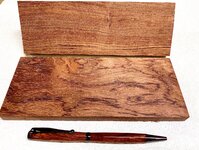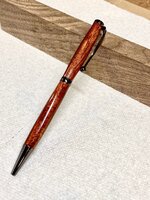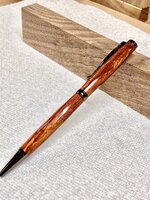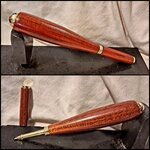TheCraftyCarver
Member
So, I found this stuff in the bargain bin of scrap wood at woodcraft and I've been trying to identify it. Also, I added photos of the pen I turned with it (pen #8!). It's finished with CA and the color really intensified & darkened with finishing! I wasn't expecting it to get so dark (& really red!) Im assuming these are the same type of wood as each other since they both has the same grain structure and color and shimmer, but one just has more dark lines than the other.
My clues are:
- Hardness/density/weight is similar to Purple Heart. It's Not super hard to work with, but not simple either.
- It burned rather quickly on the belt sander (like a curly maple will)
- There was very little scent when cutting (unlike the zebra wood I cut yesterday which is nasty! )
)
- While turning it had very orange dust, like a rusty nail, not something reddish/brown like I expected.
I'm thinking maybe bloodwood or chakte viga? It has a bit of a shimmer to it even uncut or Unsanded; it shimmers a bit just by moving it around and while not "curly" it has a shimmer that most woods don't. It's really nice and id like to hunt more down eventually but don't know what it's called. It was only 1/2 thick, so I was able to make a slimline with it, but I'd like to find some thicker stuff in future.
what do you guys think? (& I used some walnut to prop the pen on if that gives you some hint for color contrast)
Also, my Pen #8 is a "fancy slimline" in gunmetal (I would have used antique gunmetal but I'm waiting for more to arrive from Turners Warehouse). I have the HARDEST time trying to pair woods with metal finishes and am never sure if I "got it right"
My clues are:
- Hardness/density/weight is similar to Purple Heart. It's Not super hard to work with, but not simple either.
- It burned rather quickly on the belt sander (like a curly maple will)
- There was very little scent when cutting (unlike the zebra wood I cut yesterday which is nasty!
- While turning it had very orange dust, like a rusty nail, not something reddish/brown like I expected.
I'm thinking maybe bloodwood or chakte viga? It has a bit of a shimmer to it even uncut or Unsanded; it shimmers a bit just by moving it around and while not "curly" it has a shimmer that most woods don't. It's really nice and id like to hunt more down eventually but don't know what it's called. It was only 1/2 thick, so I was able to make a slimline with it, but I'd like to find some thicker stuff in future.
what do you guys think? (& I used some walnut to prop the pen on if that gives you some hint for color contrast)
Also, my Pen #8 is a "fancy slimline" in gunmetal (I would have used antique gunmetal but I'm waiting for more to arrive from Turners Warehouse). I have the HARDEST time trying to pair woods with metal finishes and am never sure if I "got it right"
Attachments
Last edited:




